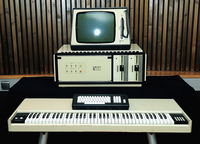|
Still Life. The Fairlight CMI |
|
| deutsch |
|
|
Norbert Math,
Published in
Zauberhafte Klangmaschinen (Magical Sound Machines)
Online text version with sound: Zauberhafte Klangmaschinen |
The Fairlight Computer Music Instrument I, an Australian invention, introduced two new techniques, Sampling and Sequencing 1| – sparked not least by the record Switched-on Bach, as Peter Vogel, one of the inventors, writes on his homepage. 2| The aim was to create an instrument that could provide the sound possibilities of a Moog, was easy to operate and allowed the user to control a maximum of sound parameters. However, after years of work on a prototype (the Qasar), it became apparent that such a machine was impossible. The oscillations of an analogue instrument, whether a Moog or a violin, always include small instabilities that contribute to the "liveliness" of the sound. A digital instrument must calculate such instabilities artificially. The means available at the time were far from being capable of doing this. Vogel and Ryrie then used a trick: short recordings (samples) would capture the liveliness of natural sound sources. Admittedly, natural sounds had already been used as basic material (such as in the mellotron or the optigan), but the digital world allows much freer means of manipulation. The sound can now be reproduced in breach of all physical laws, forwards and backwards, at any speed, in any number of voices and in endless loops. By 1979, the Fairlight CMI had advanced sufficiently for Peter Vogel to take it to Europe and present it to the musician Peter Gabriel.He immediately used the instrument on his latest record3| and organized the marketing. The Fairlight CMI was immediately so successful that around 300 models in various versions were sold within a few years despite it being hugely expensive. A large part of 1980s pop music was produced with the help of the Fairlight CMI. The first music created entirely with the Fairlight CMI was Erdenklang by Hubert Bognermayr and Harald Zuschrader.4| "Bognermayr and Zuschrader achieved the ultimate dream of all composers: to have the power to make use of all the sounds of the world around them and all conceivable sounds of their own compositional imagination. [...] The sound of the future is an amalgam – the contrasting pair of crystal clear natural sounds and electroacoustically distorted power sound has been overcome."5| Control over all the sounds of the environment promised to unite natural sounds and the electroacoustic. Bognermayr and Zuschrader, however, overlooked the fact that nature is merely subordinated to their compositional activity as material ¿ the terms "sampling" and "sequencing" are not derived from biology by accident. Nature is presented as an imitation still life. To quote Peter Gabriel: "Fox the fox / Rat on the rat / You can ape the ape / I know about that."6| But nature is not essential. In 1983, the film music for Liquid Sky (directed by Slava Tsukerman, music by Brenda Hutchinson and others) was produced on the Fairlight CMI. An artificial world of punk, fashion, drugs and aliens is submerged in classical compositions (including Orff and Marais) that are sampled and sequenced, returning the music, art, back into itself. And thus sampling was invented a second time: music multiplied by itself, a technique that was for instance to become fundamental for hip-hop. In a key scene in the film, a performer appears with her drum computer and declaims: "Me and my rhythm box. / Are you jealous folks? / My rhythm box is sweet. / Never forgets a beat. / [...] / It's always high. / So am I ... / Do you want to know why? / It... / It is ... / Preprogrammed. / So what? So what? So what? So what? So what? / Who of your friends is not?"7|
1| The following text only deals with sampling. A sequencer is a program that can store, process and reproduce musical instructions; hence it is a score and a performer rolled into one. The principle of sequencing corresponds with the perforated holes of mechanical piano. 2| http://www.anerd.com/fairlight/ (Juni 2008). 3| Peter Gabriels third album Melt (1981). 4| Bognermayr and Zugschrader¿s symphony was first performed at the 1982 Ars Electronica as ¿Computerakustisches Tanztheater Erdenklang.¿ 5| Booklet to the CD, Erdenklang Musikverlag 1982. 6| Peter Gabriel, Shock The Monkey, on his fourth album Security, 1982. According to Matthias Becker (Synthesizer von gestern, Vol. 2, Augsburg 1995) the first thing the inventors sampled was the barking of their dog – "his dog¿s voice" as it were. 7| Courtenay Gallon, Liquid Sky: Cult Cinema, Film Scoring, and the Fairlight CMI, Dissertation (http://etd.lib.fsu.edu/theses/available/etd-11132007-163416/unrestricted/cgg_thesis.pdf). |
